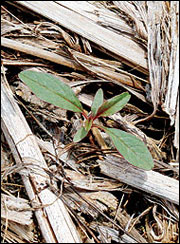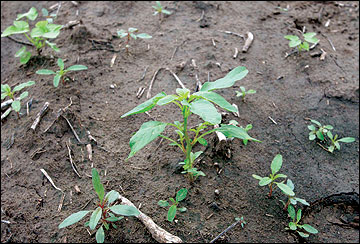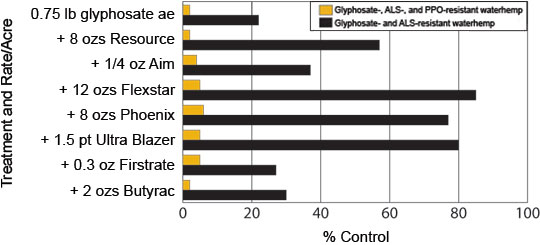

Figure 1
Close-up of a waterhemp seedling. Thousands of waterhemp seedlings are usually found in a small area as this weed can produce as many as 1 million seeds per plant.
Figure 2
Waterhemp plants have hairless stems and long lance-shaped leaves that are waxy or glossy in appearance.
Waterhemp, Amaranthus rudis, is a summer annual weed in the pigweed family that is found throughout the Midwest. Waterhemp seedlings have oar-shaped or oval cotyledons (seed leaves) and are hairless (Figure 1), unlike redroot or smooth pigweed. Mature waterhemp plants have long, lance-shaped leaves that are waxy or glossy in appearance (Figure 2). Plants can range in height from 4 inches to 12 feet depending on growing conditions, and they can grow as much as 1 inch per day during the summer growing season.
In surveys conducted in Illinois and Missouri, producers and agricultural retailers listed waterhemp as one of the most common and troublesome weeds encountered in soybean production. Waterhemp is a prolific seed producer, capable of producing about one-and-a-half times more seed than most other pigweed species. Waterhemp plants generally produce about 250,000 seeds per plant, although some plants can produce as many as 1 million seeds when growing under optimal conditions in noncompetitive environments. Waterhemp seeds have a discontinuous emergence pattern and can germinate later in the season than most summer annual weed species. This allows waterhemp to escape many preemergence (PRE) herbicide applications and often allows this weed to flourish after postemergence (POST) applications of non-residual herbicides like glyphosate (sold as Roundup or a variety of other trade names). Waterhemp seed can also persist in the soil for as many as four years with 95 percent of the seed remaining viable after this time.
Herbicide resistance in waterhemp
Waterhemp has a remarkable ability to adapt to the selection pressure imparted by herbicides and has evolved resistance to many different classes of herbicides. Waterhemp populations have evolved resistance to atrazine; to ALS-inhibiting herbicides such as Pursuit and Classic; to PPO-inhibiting herbicides such as Blazer, Cobra, Flexstar and Phoenix; and most recently to glyphosate. The first confirmation of glyphosate-resistant waterhemp occurred in Platte County, Mo., in 2005. This waterhemp biotype was 19 times more resistant to glyphosate than a susceptible biotype and was confirmed to also be resistant to ALS- and PPO-inhibiting herbicides. This phenomenon of ALS- and PPO- resistance also has been documented with waterhemp populations in Kansas, Illinois and Missouri. Since the initial confirmation of glyphosate-resistant waterhemp in Missouri, additional populations have been confirmed in Missouri, Illinois, Kansas and Minnesota. All of these populations evolved resistance to glyphosate after repeated applications of the herbicide in the same fields over time. In the Platte County location where glyphosate-resistant waterhemp was first identified, at least one application of glyphosate had been made to Roundup Ready soybeans each year for seven years.
The confirmation of glyphosate resistance in waterhemp is concerning because this weed is dioecious, meaning that male and female flowers occur on separate plants. Male flowers produce pollen, which is wind-disseminated to fertilize females, which then produce the seed. The significance of this is that pollen can transfer the resistance trait to a previously glyphosate-susceptible female waterhemp in another area. The female will then produce seed, some of which will be glyphosate-resistant.
The exact distance that waterhemp pollen might be able to travel is unknown, but some researchers speculate that waterhemp pollen could travel at least a half-mile from the source plant.
In 2006 and 2007, surveys revealed that glyphosate-resistant waterhemp occurred in at least six counties and on at least 4 percent of total soybean acres in Missouri. In 2008, more instances of glyphosate-resistant waterhemp were reported. Glyphosate-resistant waterhemp should be a major concern for Missouri corn and soybean producers because of the prevalence of this species throughout the state and the heavy reliance on glyphosate for weed management. Below are recommendations to manage glyphosate- and/or multiple-resistant waterhemp in corn and soybeans that are based on results from three years of field research conducted on glyphosate- and multiple-resistant waterhemp populations in Missouri.
Management recommendations
Corn
In the majority of documented cases, glyphosate-resistant waterhemp has developed in continual Roundup Ready soybean systems where glyphosate has been used continually with little or no use of alternative herbicides. Therefore, one of the most effective and economical methods to prevent or manage glyphosate-resistant waterhemp is to rotate to corn and use alternative herbicides. In corn, a wide variety of preemergence (PRE) herbicides will provide good control of glyphosate-resistant waterhemp, including: metolachlor (Cinch, Dual II Magnum), acetochlor (Degree, Harness, Surpass, TopNotch), alachlor (MicroTech), isoxaflutole (Balance Pro, Balance Flexx), mesotrione (Callisto, also in Camix), dimethenamid (Outlook), and any of the various atrazine premixes that contain these herbicides (Bicep II Magnum, Bullet, Cinch ATZ, Degree Xtra, Fultime, Guardsman Max, Harness Xtra, Keystone, Lariat, Lexar, Lumax and others). Herbicides that provide good control as postemergence (POST) treatments in corn include: atrazine, 2, 4-D, dicamba-containing herbicides (Banvel, Celebrity Plus, Clarity, Distinct, Marksman, NorthStar, Status, Yukon), Callisto, Impact, Laudis, and Liberty or Liberty tank mixes in Liberty Link corn. When treating waterhemp POST, it is very important to ensure that herbicides are applied to the correct stage of the crop and the weed based on label recommendations of the herbicide.
Soybean

Figure 3
Influence of soybean herbicide programs on late-season waterhemp density at a site with glyphosate-, ALS- and PPO-resistant waterhemp or glyphosate- and ALS-resistant waterhemp. (*fb=followed by; PRE=preemergence; POST=postemergence)

Figure 4
Influence of herbicide programs on net income when glyphosate-, ALS- and PPO-resistant waterhemp is present in soybeans. (*fb=followed by; PRE=preemergence; POST=postemergence)

Figure 5
Influence of glyphosate tank-mix partner combinations on multiple-resistant waterhemp control. Plus signs indicate combinations of the herbicide and rate indicated with .75-pound glyphosate ae/acre.
Despite the effectiveness of alternative corn-herbicide programs, many growers still require options to manage glyphosate-resistant waterhemp in soybean. Figures 3 to 5 provide results from research pertaining to the management of a glyphosate-, ALS- and PPO-resistant waterhemp population and an ALS- and glyphosate-resistant waterhemp population in soybean. As illustrated in Figure 3, a residual preemergence (PRE) herbicide applied before soybean planting is the most important factor in managing glyphosate-resistant waterhemp. In a site with glyphosate-, ALS- and PPO-resistant waterhemp, PRE herbicides reduced late-season waterhemp density by at least 97 percent compared with a single postemergence (POST) application of glyphosate plus a PPO-inhibiting herbicide. See Table 1 for a list of PRE soybean herbicides that provide effective control of herbicide-resistant waterhemp. Programs containing PRE herbicides also increased net returns from $77 to $110 more per acre than a POST-only glyphosate program (Figure 4).
At a site with only ALS- and glyphosate-resistant waterhemp, POST applications of a PPO-inhibiting herbicide were much more effective, but still resulted in 10 waterhemp plants per m2 (Figure 3), the equivalent of about 40,500 waterhemp plants per acre. On a per-acre basis, this infestation level could return millions of resistant waterhemp seed back to the soil. The results shown in Figure 5 confirm that it is difficult to achieve effective control of herbicide-resistant waterhemp with POST-only applications of glyphosate plus another tank-mix partner in soybean. These studies reveal that there are essentially no POST tank-mix options for the control of a waterhemp population with resistances to glyphosate-, ALS- and PPO-inhibiting herbicides. If only ALS- and glyphosate-resistant waterhemp is present, the addition of the PPO-inhibiting herbicides Flexstar, Phoenix or Ultra Blazer can provide acceptable control, but complete control with these programs is unlikely, and some waterhemp seed production is still likely to occur. The size of the waterhemp at the time of application is also an important consideration, for most PPO-inhibiting herbicides are only labeled for control of waterhemp six inches or shorter.
A final option to manage glyphosate- or multiple-resistant waterhemp in soybeans is to use new herbicide-tolerant crops and herbicides with an alternate mode of action, such as Ignite (glufosinate) in Liberty Link soybean. Preliminary research shows that Ignite applied to Liberty Link soybean can effectively control glyphosate- or multiple-resistant waterhemp, but the waterhemp size at the time of application determines the level of control achieved. In the Liberty Link system, the best programs to manage multiple-resistant waterhemp also include a PRE herbicide soon before or after planting, followed by a POST Ignite application on waterhemp 3 to 4 inches tall.
Soybean recommendation summary
- Soon before or after soybean planting, apply a PRE residual herbicide with good activity on waterhemp.
- If glyphosate resistance is known or suspected and there is no reason to believe the population is also resistant to PPO-inhibiting herbicides, apply a PPO-inhibiting herbicide such as Flexstar, Phoenix or Ultra Blazer to waterhemp shorter than 6 inches tall. Glyphosate can also be applied in combination with a PPO-inhibiting herbicide, depending on the spectrum of other weeds present in the field.
- If glyphosate- and PPO-resistance is known or suspected, between-row cultivation is the only option for waterhemp escapes in Roundup Ready or conventional soybean systems. In Liberty Link soybean systems, apply Ignite to waterhemp escapes shorter than 4 inches tall.
Table 1
Resistant waterhemp response to preemergence and postemergence herbicides in soybeans.
| Herbicide | Active ingredient(s) | ALS- and glyphosate-resistant waterhemp* | ALS-, PPO- and glyphosate-resistant waterhemp* |
|---|---|---|---|
| Preemergence (PRE) | |||
| Authority Assist | sulfentrazone + imazethapyr | E | E |
| Authority First/Sonic | sulfentrazone + cloransulam | E | E |
| Authority MTZ | sulfentrazone + metribuzin | E | E |
| Boundary | S-metolachlor + metribuzin | E | E |
| Canopy | chlorimuron + metribuzin | F | F |
|
Canopy EX |
chlorimuron + tribenuron | P | P |
| Dual II Magnum, others | S-metolachlor | G/E | G/E |
| Envive | flumioxazin + chlorimuron + thifensulfuron | G | G |
| FirstRate | cloransulam | P | P |
| Gangster | flumioxazin + cloransulam | G | G |
| IntRRo/Micro-Tech | alachlor | F/G | F/G |
| Outlook | dimethenamid | G | G |
| Prefix | S-metolachlor + fomesafen | E | E |
| Prowl H2O, others | pendimethalin | F/G | F/G |
| Pursuit | imazethapyr | P | P |
| Python | flumetsulam | P | P |
| Scepter | imazaquin | P | P |
| Sencor | metribuzin | F | F |
| Treflan, others | (PPI only) trifluralin | F/G | F/G |
| Valor | flumioxazin | G | G |
| Valor XLT | flumioxazin + chlorimuron | G | G |
| Postemergence (POST) | |||
| Aim | carfentrazone | F | F |
| Butyrac, others | 2,4-DB | P/F | P/F |
| Classic | chlorimuron | P | P |
| Cobra/Phoenix | lactofen | G/E | P |
| FirstRate | cloransulam | P | P |
| Flexstar/Reflex | fomesafen | G/E | P |
| Harmony | thifensulfuron | P | P |
| Pursuit | imazethapyr | P | P |
| Raptor | imazamox | P | P |
|
Resource |
flumiclorac | F | F |
|
Scepter |
imazaquin | P | P |
|
Synchrony XP |
chlorimuron + thifensulfuron | P | P |
|
Ultra Blazer |
acifluorfen | G/E | P |
| Ignite (Liberty Link Soybean only) | glufosinate | G | G |
| Roundup (Roundup Ready Soybean only) | glyphosate | P | P |
*E= Excellent (>90 percent control); G=Good (75 to 89 percent control); F=Fair (60 to 74 percent control); P=Poor (<60 percent control)